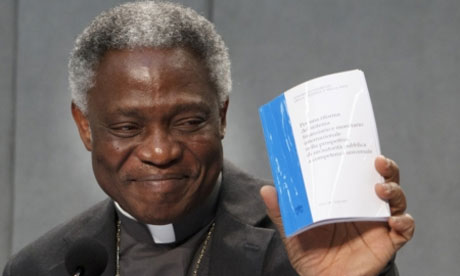The unusual and somewhat mysterious gestation process of Vatican documents came into the spotlight recently, thanks to a controversial white paper on economic justice.
In essence, critics of the document – which called for a global authority to curb the excesses of financial markets – speculated that its authors had done an “end run” to avoid the pre-publication scrutiny of top Vatican officials.
Cardinal Peter Turkson, president of the Pontifical Council for Justice and Peace, speaks at a Vatican press conference on the Vatican document on global finance. The document called for a gradual creation of a world political authority with broad powers to regulate financial markets and rein in the “inequalities and distortions of capitalist development.” (CNS/Paul Haring)
That turned out not to be true, but the episode illustrated that the editing and approval procedures at the Vatican are less than transparent and far from uniform.
The 41-page text on reforming the international financial system was prepared by the Pontifical Council for Justice and Peace. Among other things, it proposed a “central world bank” to regulate the flow of monetary exchanges, and taxation on financial transactions to aid the economies of poorer countries.
Critics immediately tried to downplay the importance of the document and argued that the justice and peace council was a minor player at the Vatican. Then in mid-November, an Italian blogger reported that the Vatican secretary of state, Cardinal Tarcisio Bertone, had been blindsided by the text and had ordered that, from now on, all such documents must have the prior approval of his office.
The real back story was far different.
Continue reading about the Vatican’s financial document complex route to publication
Image: Boston Pilot
Additional reading
News category: Features.




